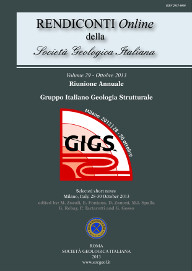
Caldera evolution in Campi Flegrei: the role of fractures and faults
Stefano Vitale (a) & Roberto Isaia (b)
(a) Dipartimento di Scienze della Terra, dell'Ambiente e delle Risorse (DiSTAR), Università di Napoli Federico II, Largo San Marcellino 10, 80138, Napoli, Italy.
(b) Istituto Nazionale di Geofisica e Vulcanologia, sezione di Napoli Osservatorio Vesuviano, Via Diocleziano 328, 80124 Napoli, Italy.
DOI: https://doi.org/
Volume: 29/2013
Pages: 191-193
Abstract
Fractures and faults hosted in volcanic rocks in Campi Flegrei were analyzed. The fracture pattern suggests a prevalence of NE-SW and NW-SE directions and secondarily N-S and E-W trends occur. Faults often appear as conjugate structures showing normal kinematics, at places associated with ductile deformation suggesting a syn-eruption deformation. However the most of faults, mainly hosted along the caldera/crater rims, are very steep with dominant normal and secondary reverse movements. Fractures and faults found in rocks older than 15 ka (Neapolitan Yellow Tuff included), measured in western and eastern sectors of the study area, indicate a rotation of ca. 30° of the main directions among these two sectors, whereas the younger rocks are widespread characterized by a slight prevalence of the “regional” NW-SE (Apennine) and NE-SW (anti-Apennine) directions. Faults occurring along the caldera/crater rims suggest a kinematic evolution characterized by the reactivation of tensile fractures previously formed in response to both regional extension and local resurgent dome.
Keywords
Get Full Text